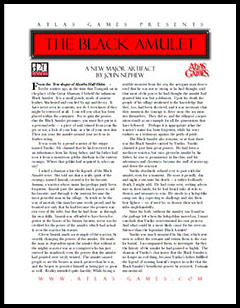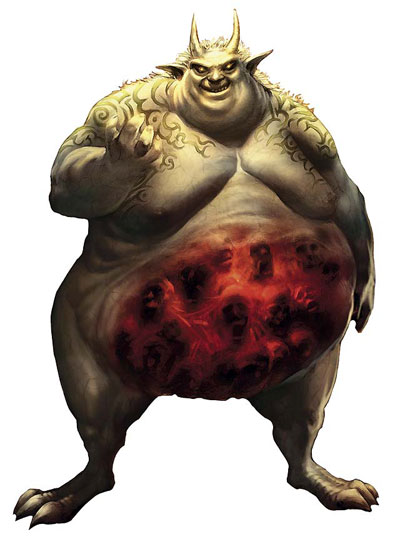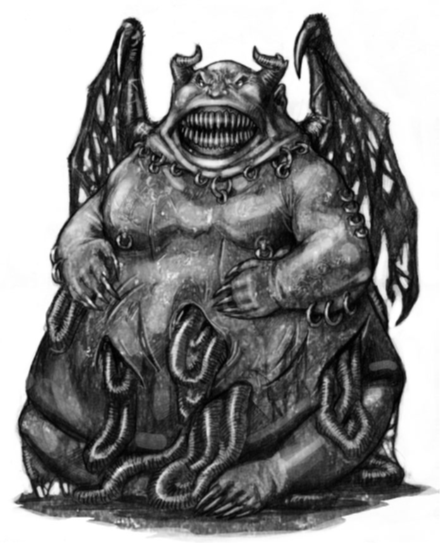
SESSION 40C: MALLECK’S LAST STAND
July 25th, 2009
The 22nd Day of Kadal in the 790th Year of the Seyrunian Dynasty
While Ranthir collected the books, the others were dumping the cultists’ bodies onto the lighted panels, which sucked the blood out of them and schlepped it down to the sewer.
“That’s gross,” Elestra said, watching the blood run in twisting rivulets away from them.
“Remind me not to stand on these things with an open wound,” Tee said.
They joined Ranthir in the library. Tee checked the doors, finding them all locked. Picking the nearest one at random, she flipped open her ring of lockpicking tools and set to work.
She had just gotten the door unlocked, however, when a piercing scream ripped its way through the complex. She sighed and relocked the door.
The scream sounded as if it came from the far end of the complex. They headed up a short flight of stairs and down a long hall that seemed to head in the right direction. Nearing the end of the hall, Tee caught the faint sounds of conversation coming from somewhere ahead and she waved the others to hold back and hold silent. Peering around the corner she looked through a door into what appeared to be one end of a larger barracks. There was definitely someone in there, but they were out of sight. In the opposite direction – the direction she felt the scream had come from – was another short flight of stairs leading up.
At Tee’s direction – and following Tor’s lead – they rounded the corner and headed up the stairs. These led into a large, open common room containing several tables, a few divans, several cushioned chairs, and a number of deformed stone idols.
Two cultists were on guard duty here, but they seemed lax in their duties: One was leaning lackadaisically against the wall while the other sat on a chair, sharpening his sword. Tor, still under the camouflaging effects of Elestra’s communion with the Spirit of the City, was able to sneak along the wall and kill the first without the other even noticing. When he went for the sword-sharpener, however, the cultist got a turn of good luck, narrowly dodging Tor’s thrust. But his luck lasted for only a moment: As he opened his mouth to give a warning shout, Tor cut him down in a gasping gurgle.
Another scream rended the air. They whirled towards the source, heading down a long flight of stairs that opened into a long, wide, sconce-lit hall. The staircase emerged above the floor of the hall and descended through open air, although along the nearest end it was flanked by two broad ledges which could be reached by independent stairs from the chamber floor.
The walls and the floor below were of black-and-red swirled marble. In the center of the lower floor was a large table of inclined stone. Strapped to this table was a young boy, his body wracked in the midst of some sort of horrible transformation: One arm had grown bulbous with rippling black muscles, his skin was mottled with a sickly green growth, and pus-filled sores were sprouting across his entire body and blood streamed from wounds that seemed to open and close of their own accord. His face was rictused in agony.
Standing nearby were two priests in white robes marked with the black hand of the Ebon Hand. They were manipulating syringes and checking injection tubes that had been plunged into the body of the transforming boy. Their work was being overseen by another man with mottled grey skin streaked with serpentine green wearing an ebony headdress.
Two more priests were standing near the end of the stairs. Their attention was given wholly to the grim proceedings before them. Tee – barely suppressing the rage she felt at the scene – was easily able to pass silently down the stairs. The priests weren’t aware of her until she sent one of their heads flying down the length of the chamber.
It landed near the feet of the man with the mottled grey skin. The priests stared down at it for a moment dumbly, and before they had a chance to process what was happening Tor had charged down the stairs and thrown them into complete disarray.
The grey-skinned man turned to one of the priests, “Give me your potion! Now!”
“Yes, Malleck.”
“It’s Malleck!” Tee cried with triumph.
Malleck swallowed the potion and disappeared.
“Dammit!”
MALLECK’S LAST STAND
Tee and Elestra laid down a volley of dragon pistol fire, forcing the remaining priests to backpedal rapidly as Agnarr moved to engage them. Tor, however, had shut his eyes, thinking back to the long hours of blind-folded training he had practiced back on his ranch. It seemed so long ago, and yet—
His sword lashed out. A spray of arterial blood spread across the wall and the venomed curses of Malleck could be heard clearly over the sounds of the nearby melee.
Tor opened his eyes with a grim smile. But suddenly a secret panel in the far wall slid open… and slid shut again. Malleck had escaped! Tor threw himself at the door, but was left searching helplessly for the mechanism to open it.
Two of the remaining priests called upon dark gods in a sibilant, twisted tongue. Hands of crackling black energy appeared in the air before them—And Agnarr’s flaming blade ripped through them and turned the priests behind them into smoldering ruins. In their last instants, the hands actually tried to flee from the enraged barbarian as they flickered out ineffectually. Elestra summoned lightning from the air itself to immolate the last of the priests.
Ranthir waved a hand over his feet and set off with expeditious speed back up the long stairs, hoping that he might be able to cut Malleck off from his escape.
Tee, meanwhile, was racing in the opposite direction. She hit the wall where Malleck had disappeared with her ring and in a burst of blue energy the panel slid open. Passing through it, she found herself back in the library. The blood trail ended abruptly (Tee guessed that Malleck had magically healed himself), but Tee’s sharp nose caught the passing of his scent. With something of a wild guess, she directed Elestra to send a burst of lightning in that direction—
And struck the invisible Malleck!
Malleck howled with pain. He was still invisible, but Tor followed his voice and caught him in another spray of blood.
“May the Galchutt consume you!” Malleck appeared, his hand outstretched towards them. A pillar of fire erupted around Tor.
Malleck turned to make good his escape, but Ranthir – racing down the hall from the opposite direction – stretched out his own hand and enmeshed Malleck in an impenetrable web. Malleck managed to wrench his way free from the sticky mass, but found himself trapped and backed into a corner as Tor and Agnarr closed in on him.
“Help! Help! To arms! The compound is under attack! We’re under attack!”
THE FALL OF THE TEMPLE
Agnarr, having burned his way through the web using his sword, plunged his sword into Malleck’s body. Tee, meanwhile, had heard the commotion of reinforcements drawn to Malleck’s final rallying cry. She called for the others to fall back through the secret door… only to discover that her ring had, unfortunately, disabled its mechanism. They couldn’t shut it.
Tor, taking up the rear of their retreat back into the laboratory, heard a door slam nearby and the rush of footsteps drawing nearer. Then voices cried out: “Malleck is down! Get him!”
During Malleck’s last stand, Nasira had turned her attention to the boy. She found that his heart was failing him. The process that was transforming him was obviously botched and incomplete and now it was killing him.
Hearing this, Agnarr couldn’t contain his rage. He was furious over the boy. With a grim look of determination he charged back out through the secret door.
“Agnarr!” Tee screamed. “What are you doing?!”
Agnarr found two cultist guards trying to haul Malleck out of the web. He cut them down with a single furious sweep of his blade.
But there were at least a dozen more of the cultists charging down the hall towards him. Agnarr whirled towards them…
And was joined by Tor, who gave him an ironic nod. “Well, since you’re out here anyway…”
Side-by-side they charged up the stairs and into the long hall. Tee, meanwhile, had gone back up the long-stairs and circled around to the far side of the barracks. She was waiting for the waves of reinforcements to run dry, but they just kept coming.
Elestra joined Tor and Agnarr in the hall, using the last of her lightning to chew up the back ranks of the cultists. For a moment it looked as if their morale might break.
But then a woman in red and black full plate – a red cape with a black hand embroidered upon its swirling across her back – emerged from the barracks. She started barking orders and rallying cries to the nearest soldiers.
Agnarr held his ground to keep the cultists from converging on Elestra, but Tor began to cut a path towards the woman. As Tor drew near, the woman saw him isolated from his companions. She carefully circled their skirmish, trying to flank him… but she was caught completely off-guard as Agnarr surged his way forward and came up behind them with preternatural speed. She was cut down before she realized the danger that was upon her.
Tee, thinking the woman to be the last of the cultists coming from that direction, emerged from her place of hiding in an effort to circle around the others and flank them. But as she did, two cultist priests came rushing out of the barracks and caught her standing in the middle of the hall. They sneered at her. “Trying to flee, eh?”
They took two steps towards her and then glanced down the length of the hall… where they saw the devastation wrought by Agnarr, Tor, and Elestra.
They turned and ran back into the barracks.
Running the Campaign: Moral Dilemmas of Magic – Campaign Journal: Session 40D
In the Shadow of the Spire: Index
















